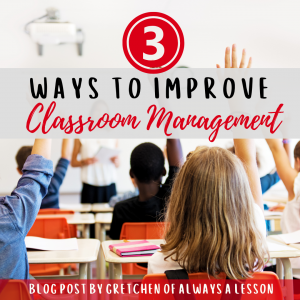3 Ways to Improve Classroom Management Practices in the Classroom
Classroom management that is effective creates more time on task for student learning. This creates more rounds of practice to solidify new learning and increase learning outcomes. When teachers are consistent in their classroom management practices, students reap the benefits!
This post will explore 3 ways to improve classroom management practices in the classroom.
Relationships
 Connecting human-to-human in terms of interests, personality and preferences brings the class together as one. When the teacher invests in their students before delivering content, trust develops. After trust, the student is willing to take more risks and be transparent in the learning process. Now the teacher is able to best help the student because they have formed a deep connection and they know how to best design lessons taking into account the uniqueness of each student. This increases student motivation to comply with class rules, limiting behavior disruptions during class time.
Connecting human-to-human in terms of interests, personality and preferences brings the class together as one. When the teacher invests in their students before delivering content, trust develops. After trust, the student is willing to take more risks and be transparent in the learning process. Now the teacher is able to best help the student because they have formed a deep connection and they know how to best design lessons taking into account the uniqueness of each student. This increases student motivation to comply with class rules, limiting behavior disruptions during class time.
Routines
Routines provide structure to how the classroom operates. It is a road map of sorts, giving direction for what and how. When teachers plan routines ahead of time, they are being proactive in managing their classroom. Instead of waiting for a problem to erupt and then eating up class time remedying that problem, teachers have thought through potential hot spots and put routines in place to prevent them from occurring in the first place. Once a routine has been planned, teachers must teach it in isolation to students. Students then practice and implement the routine, receiving feedback on their performance. This can take days or weeks for a single routine. Routines can be reused for various activities such as details, volume, pace, location, format direction, and more. Learn more about routines with my PD in a Box tool. You may also find this checklist helpful!
Rope Students In
Engagement is key to having students open and motivated to learn. By making learning material appealing, teachers can entice students to engage fully in the learning experience. This is referred to as “roping students in.” Teachers can do this by utilizing pacing that feels just right for various learners (ie. fast lanes for those qho understand quickly and speed bumps for those that need to slow down and try again). Also, by including a plethora of engagement options for student discourse and interaction (ie. turn/talk, gallery walk, socratic seminar), it provides students with choice and voice. When they feel like they are not forced to learn in a specific way, can engage in a way that is interesting to them and allows them to voice their opinion, they lean into learning. Differentiation is key at this stage!
What’s next?
Want to learn more about the three ways to improve classroom management practices plus gain even more strategies to become more effective in the classroom? Read Always A Lesson: Teacher Essentials for Classroom and Career Success. More classroom resources are also available here. Also, catch up on other helpful blog posts here.
GO BE GREAT!

Which classroom management practice are you most excited about trying in your classroom?
